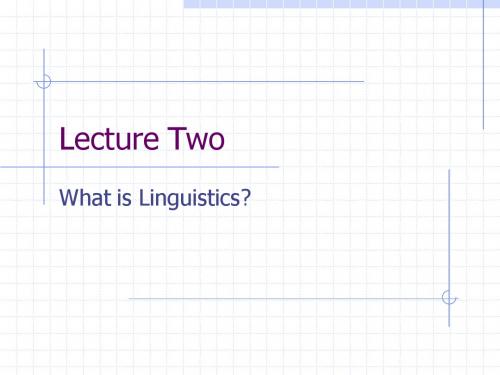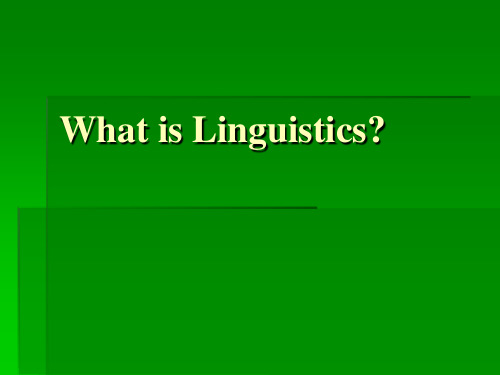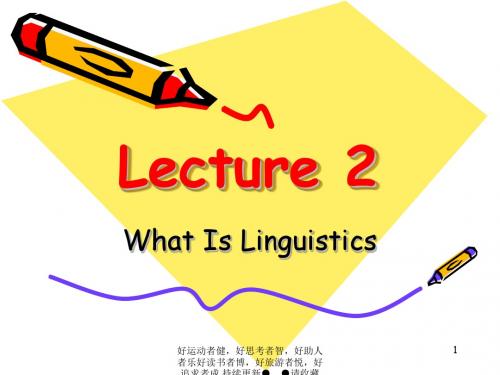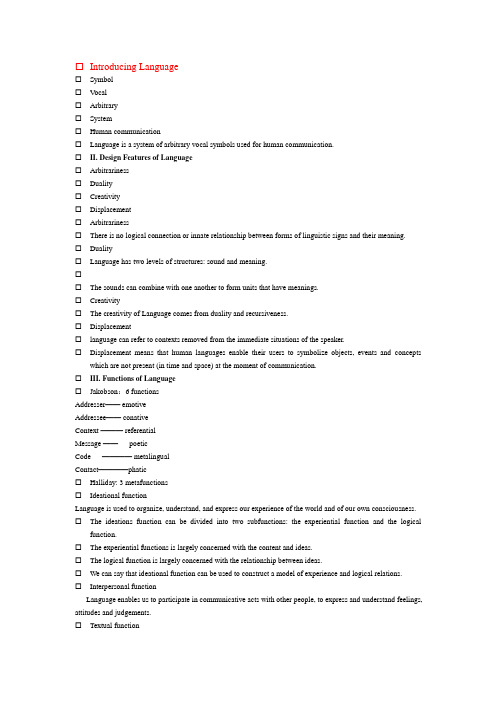Lecture 2 Introducing Linguistics
- 格式:ppt
- 大小:283.00 KB
- 文档页数:29

关于“习得”与“学得”的重新认识及其对外语教学的启示摘要:自20世纪70年代开始,第二语言习得一直是语言学研究领域的一个热门话题。
近几十年以来,这一领域发展迅速并且已经成为一门独立的学科。
但是学界对于“二语习得”这一名词的界定仍有许多异议,对于第二语言究竟是“习得”还是“学得”这一问题的讨论从来没有停止。
基于对前人文献的对比和分析,笔者试图通过本文来重新认识“习得”与“学得”的异同,同时通过分析这两者的异同能得到一些对于外语教学的启示。
关键词:习得;学得;外语教学1.语言习得与学得纵观21世纪初以前的文献,受克拉申(Krashen)习得—学得假说的影响,学者们普遍认为学习和习得是两种不同的方式和过程,而这两者的使用也有较为清晰的界限。
一般来说,习得是指儿童学习其母语(第一语言)的过程,而学得是指成人学习第二语言(甚至第三、四……)的过程。
根据Krashen的假说来看,学习在英文中叫Learning,习得是从英文中Acquisition(获得)这个词衍生而来。
习得是通过一种潜意识的方式进行的,学习者在习得的过程中并不知道自己在习得该语言,同时也不知道自己在用该语言进行交际行为,在此过程中习得和获得的知识都是潜意识的。
学得则是通过一种有意识的方式,系统性地学习该语言的语言结构和语法规则,这种学习是系统的、正规的。
Krashen习得—学得假说中最为重要的一点就是认为习得与学得的知识不能够相互转化,这两个过程是各自分开的也是毫无交集的。
而这一点也是颇受争议,在现在看来,习得与学习虽然有着形式上的差别但本质上还是相同的,都是人类学习的一个过程,而且也很难区分一个人的知识到底是习得的多还是学得的多。
根据Krashen的习得—学得理论,笔者认为克氏的理论过分强调了习得与学得的不同而没有看到二者之间的联系。
就拿其对习得的概念定义来说,Krashen 认为习得是儿童学习母语的过程,在这一过程中没有人刻意地去教儿童,但儿童总能够学会语言。




☐Introducing Language☐Symbol☐V ocal☐Arbitrary☐System☐Human communication☐Language is a system of arbitrary vocal symbols used for human communication.☐II. Design Features of Language☐Arbitrariness☐Duality☐Creativity☐Displacement☐Arbitrariness☐There is no logical connection or innate relationship between forms of linguistic signs and their meaning.☐Duality☐Language has two levels of structures: sound and meaning.☐☐The sounds can combine with one another to form units that have meanings.☐Creativity☐The creativity of Language comes from duality and recursiveness.☐Displacement☐language can refer to contexts removed from the immediate situations of the speaker.☐Displacement means that human languages enable their users to symbolize objects, events and concepts which are not present (in time and space) at the moment of communication.☐III. Functions of Language☐Jakobson:6 functionsAddresser—— emotiveAddressee—— conativeContext ——— referentialMessage ——poeticCode ———— metalingualContact————phatic☐Halliday: 3 metafunctions☐Ideational functionLanguage is used to organize, understand, and express our experience of the world and of our own consciousness. ☐The ideations function can be divided into two subfunctions: the experiential function and the logical function.☐The experiential functions is largely concerned with the content and ideas.☐The logical function is largely concerned with the relationship between ideas.☐We can say that ideational function can be used to construct a model of experience and logical relations.☐Interpersonal functionLanguage enables us to participate in communicative acts with other people, to express and understand feelings, attitudes and judgements.☐Textual functionLanguage is used to relate what is said (or written) to the real world and to other linguistic events.☐This involves the use of language to organize the text itself or to create relevance to context.☐Functions of language in the textbook☐Informative function☐Interpersonal function☐Performative function☐Emotive function☐Phatic function☐recreational function☐metalingual function☐Lecture 2 Linguistics☐The definition of Linguistics☐Main branches of linguistics☐Macrolinguistics☐Some important distinctions in linguistics☐I. Definition of Linguistics☐Linguistics can be defined as the scientific study of language.☐The Principles for evaluating the study of language☐Exhaustiveness☐The linguists should gather all the materials relevant to his investigation and give them an adequate explanation.☐Consistency☐There should be no contradiction between different parts of the total statement.☐Economy☐Other things being equal, a short statement or analysis is preferred to a longer or more complex one.☐Objectivity☐ A linguist should be as objective as possible in his description and analysis of data and cannot allow prejudice to influence his conclusion.☐II. Main branches of linguistics☐Phonetics☐Phonology☐Morphology☐Syntax☐Semantics☐Pragmatics☐III. Macrolinguistics☐Psycholinguistics☐Sociolinguistics☐Anthropological linguistics☐Computational linguistics☐IV. Some important distinctions in linguistics☐Descriptive/Prescriptive☐ A linguistic study is descriptive if it describes and analyses the facts observed.☐It is prescriptive if it tries to lay down rule s for ―correct‖ use of language.☐In other words, if a linguist talks about ―what is in language‖ or ―what people actually say‖, he is descriptive.☐If he tells people ―what should be in language‖ or ―what people should say‖, he is prescriptive.☐Synchronic/DiachronicThe description of a language at some point in time is a synchronic study.The description of a language as it changes through the time is a diachronic study.☐The distinction between synchronic and diachronic studies is only theoretically clear.☐In reality, it is not easy to draw a sharp line between these two aspects of language studies.The reasons are as follows:☐First, languages are in a constant state of changing.☐Secondly, the language of any speech community is never uniform.☐Thirdly, when a language changes, one set of features are not suddenly replaced by another set of features.☐Langue/paroleThis distinction is first made by the Swiss linguist, F. de Saussure early in this century.☐Langue refers to the abstract linguistic system shared by all the members of a speech community.☐Parole refers to the actualized language, or realization of langue.☐The distinction between Langue and Parole☐langue is abstract; Parole is specific to the situation in which it occurs.☐Secondly, Langue is not actually spoken by anyone; Parole is always a naturally occurring event.☐Thirdly, Langue is relatively stable and systematic; Parole is subject to personal and situational constraints.☐Competence/Performance☐The distinction is made by American linguist Noam Chomsky in 1965 in his Aspects of the Theory of Syntax (句法理论诸方面/句法理论面面观).☐Competence is the ideal language user’s knowledge of the rules of his language.☐Performance is the actual realization of this knowledge in utterances.☐Lecture 3 PhoneticsI. Three branches of phoneticsII. Speech organsIII. Classification of consonantsIV. Classification of vowels☐I. Three branches of phonetics☐Articulatory phonetics studies the production of speech sounds.☐Acoustic phonetics studies the physical properties of speech sounds.☐Auditory or perceptual phonetics studies the perception of speech sounds or how speech sounds are received or perceived by listeners.☐II. Speech organs☐Three CavitiesOral cavityNasal cavityPharyngeal cavity☐IPA☐Otto Jespersen☐International Phonetic Alphabet was published in August 1888.☐In the IPA chart, the sound segments are grouped into consonants and vowels.☐III. Classification of consonants☐Manners of articulation☐Stop/plosive☐Nasal☐Fricative☐Affricate☐Approximant☐Lateral☐Places of articulation☐Bilabial☐Labio-dental☐Dental☐Alveolar☐Post-alveolar☐Palatal☐Velar☐glottal☐Classification of vowelsCriteria☐The height of tongue raising.☐The part of tongue that is raised: front, center or back☐The length or tenseness of the vowel☐lips rounding (rounded vs. unrounded)☐Lecture 4 Phonology☐The definition of phonology☐Phonetics and phonology☐Basic unit of phonology: Phoneme☐Some important terms:minimal pairsfree variantsdistinctive featuressyllablestress☐Phonological process☐Phonological rules☐I. The definition of phonology☐Phonology is the study of the sound patterns and sound systems of languages.☐Its primary aim is to discover the principles that govern how sounds are organized in languages, and to explain the variations that occur.☐II. The distinction between phonetics and phonology☐Phonetics studies how speech sounds are made, transmitted and received.☐Phonology studies the sound patterns and sound system of languages.☐Phonetics is the study of all possible speech sounds.☐Phonology studies how speakers of a language systematically use a selection of these sounds in order to express meaning.☐III. The basic unit of phonology: phoneme☐ A sound which is capable of distinguishing one word from another in a given language is a PHONEME.☐Allophone (音位变体)The non-distinctive sounds of the same phoneme are called allophones.☐Conditions for allophones☐Phonetic similarity:The allophones of a phoneme must bear some phonetic resemblance.☐Complementary distribution:When two sounds never occur in the same environment, they are said to be in complementary distribution.☐IV. Some important terms☐Minimal Pairs (最小对立体)Word forms which differ from each other only by one sound.Free variants (自由变体)☐If two sounds occurring in the same environment do not contrast, that is, the substitution of one for the other does not produce a different word form,but merely a different pronunciation of the same word, then the two sounds are in free variation.☐Distinctive feature☐It is first proposed by Roman Jakobson (1896-1982)☐ A particular characteristic which distinguishes one distinctive sound unit of a language from another or one group of sounds from another group.☐Syllable☐The syllabic structure☐English syllabic structure (ccc)v(cccc)☐Chinese syllabic structure (c)v(c)☐Open syllable☐Closed syllable☐Maximal onset principle☐When there is a choice as to where to place a consonant, it is put into the onset rather than the coda.☐telling☐Stress☐Stress refers to the degree of force used in producing a syllable.☐Stress is a relative notion.☐Word stress: words with two syllables.☐Sentence stress: in principle, a stress may fall on any word or syllable.☐V. Phonological ProcessThree aspects of a phonological process☐ a set of sounds that will undergo the process;☐ a set of sounds produced by the process;☐ a set of situations in which the process applies.☐Typical phonological processes☐Nasalization☐Dentalization☐Velarization☐Phonological rules[-nasal]→[+nasal]/_ [+nasal][-dental]→[+dental]/_[+dental][-velar]→[+velar]/_ [+velar]☐Devoicing(清音化)A process by which voiced sounds become voiceless.☐Assimilation☐Assimilation: a process by which one sound takes on some or all the characteristics of a neighboring sound.☐Assimilation is often used interchangeably with coarticulation.☐Progressive assimilation(顺同化)☐Regressive assimilation(逆同化)☐Progressive assimilation☐If a preceding sound influences a following sound, this phenomenon is termed progressive assimilation.☐map /mæp/☐Perseverative coarticulation (后滞协同发音)☐Regressive assimilation☐If a following sound influences a preceding sound, this phenomenon is called regressive assimilation. cap-can[kæn] since-sink[siŋk]☐Anticipatory coarticulation(先期协同发音)☐The rule orderingElsewhere Condition☐The more specific rule applies first.☐Lecture 5 Morphology (I)☐What is morphology?☐What is morpheme, allomorph?☐How can morphemes be classified?☐What is morphophonemics?☐Definition of morphology☐Morphology is a branch of linguistics, which studies the internal structure of words and the rules by which words are formed.☐Morpheme☐Morpheme: The minimal (smallest) meaningful unit is known as morpheme. (语素/词素)☐Decontextualization☐morphological☐Allomorph☐Morph: the concrete form of a morpheme.☐Allomorph: concretely realized variant of a morpheme.(语素变体)☐Morpheme ―plural‖Dog+plural → dog+sBus+plural → bus+esSheep+plural →sheepGoose+plural → geese☐The morpheme ―plural‖ takes different forms in actual realization, called morphs.☐They are all allomorphs of the one morpheme.☐The classification of morphs as allomorphs is based on(i) Similarity of meaning(ii) Complementary distribution☐Classification of morphemes☐Free morphemes☐Bound morphemes☐Free morphemeThose morphemes which can occur independent of other morphemes, that is, those which constitute words by themselves.☐Morpheme☐Linguist☐Syntax☐Bound morpheme☐Those which must appear with at least another morpheme.☐ E.g. -s linguists morpemes-ly friendly☐Derivational morphemes☐inflectional morphemes☐Derivational morphemesA derivational morphemes is one that is used to derive a new word.e.g. rich→enrich operate→operation deep→deepen friend→ friendlyInflectional morpheme☐Inflectional morphemes indicate the syntactic relationships between words and thus function as grammatical markers.☐Inflectional morphemes in English☐Regular plural suffix –s (-es);☐-s (-es) indicating simple present for the third person singular;☐The possessive case of nouns;☐–er/-est attached to simple adjective or adverbs to show comparative or superlative degrees;☐The past tense marker-ed or progressive marker –ing added to verbs.☐True or false?☐Both derivational morphemes and inflectional morphemes are bound morphemes.☐Root, stem and affix☐Root is the base form of a word that cannot be further analyzed without the total loss of identity.☐That is to say, the root is the part of the word left when all the affixes are removed.☐Stem is any morpheme or combination of morphemes to which an inflectional affix can be added.That is to say, stem is the part of the word left when inflectional affixes are removed.friendships☐Root: friend☐Stem: friendship☐Affix(词缀): the collective term for the types of morphemes that can be used only when added to another morpheme.☐Affix is bound.☐Affixes can be divided into inflectional affix and derivational affix.☐According to their positions in words:Affixes can also be divided into prefix, infix and suffix.☐Morphophonemics 形态音位学☐Morphophonology 形态音系学☐Morphophonemics☐The analysis and classification of the phonological factors affecting the appearance of morphemes.☐It studies the interrelationships between phonology and morphology.☐Phonological conditioning☐The form or shape of morphemes may be conditioned by phonological factors.e.g. The negative morpheme may be realized by in-, im- or ir-.inefficient improper irregular illogical (assimilation)☐Dissimilation (异化)☐grammar (O.E.)→ glamor (M.E.)☐Arbor (Latin) → arbol (Spanish)☐Dissimilation refers to the influence exercised by one sound segment upon the articulation of another, so that the sounds become less alike, or different.☐Morphological conditioning☐Morphemes can be determined by morphological factors.a)All the allomorphs should have common meaning.b)All the allomorphs should be in complementary distribution.c)Allomorphs that share the common meaning should occur in parallel formation.。

教育部直属师范类院校学科教学(英语)招生人数、考试科目、参考书目一、北京师范大学招生人数:15人(此为2012年招生人数,推免生占百分之三十至五十)考试科目:101-思想政治理论(满分100分)、204-英语二(满分100分)、333-教育综合(满分150分)、866-语言学与英语教学(满分150分)参考书目:1.语言研究(第2版)(The Study of Language, 2nd edition),George Yule 著,外语教学与研究出版社,2000。
2.《外语学习与教学导论》,Keath Johnson著,外语教学与研究出版社,2002年。
3.《英语教学法教程》第2版,王蔷主编,高等教育出版社,2006年。
4.【教育学原理】王道俊、郭文安主编:《教育学》,人民教育出版社2009年5.【中国教育史】(1)孙培青主编:《中国教育史》,华东师范大学出版社2009年版(2)王炳照等著:《简明中国教育史》,北京师范大学出版社2007年版6.【外国教育史】张斌贤主编,王晨副主编:《外国教育史》,教育科学出版社2008年7.【教育心理学】(1)张大均主编:《教育心理学》,人民教育出版社2005年(2)陈琦、刘儒德主编:《教育心理学》,高等教育出版社2005年2012年招生简章:/ReadNews.aspx?NewsId=11072508488二、东北师范大学招生人数:复试前公布各专业招生人数考试科目:①101思想政治理论②204英语二③333教育综合④890英语教学专业基础参考书目:1.Principles of Language Learning and Teaching H. D. Brown 外语教学与研究出版社 2008年2.Introducing Linguistics 杨忠高等教育出版社3.333教育综合参考书目同北京师范大学。
研究生院网站:/zhaosheng/index.php?classid=3专业目录:/zhaosheng/shuoshi/ssml.php?zsnf=2012三、华东师范大学、招生人数:10人考试科目:初试①101思想政治理论②201英语一③333教育综合④913综合英语(A)(内容难度同专八)复试:1.英语写作(笔试)。
西班牙语专业推荐书目及阅读要求要求:1.入学前至少阅读每个专业方向中的两本书。
2.西班牙语原文小说不得少于3本。
3.用汉语或西班牙语写两份读书报告。
一、语言学1. P.H.马修斯:《缤纷语言学》,译林出版社2. R.L. Trask and Bill Mayblin: Lintroducing linguistics3. 罗常培:语言与文化,北京大学出版社4. 弗里伯恩:英语史——从古英语到标准英语,上海外语教育出版社5. 汉斯·约阿希姆·施杜里希著,吕叔军、官青译.《世界语言简史》. 山东:山东画报出版社二、西班牙语国家政治经济1. 布拉德福德·伯恩斯、朱莉·查利普著:《简明拉丁美洲史》,王宁坤译,世界图书出版公司,2009年。
2. 莱斯利·贝瑟尔编:《剑桥拉丁美洲史》各卷,吴洪英等译,当代中国出版社。
3. 弗朗西斯·福山著:《落后之源:诠释拉美和美国之间的发展鸿沟》,中信出版股份有限公司,2015年。
4. 杰夫·贝里奇、艾伦·詹姆斯著,高飞译.《外交辞典》. 北京:北京大学出版社5. 保罗·塔格特著,袁明旭译.《民粹主义》. 吉林:吉林人民出版社6. E.布拉德福德·伯恩斯、朱莉·阿·查利普著,王宁坤译.《简明拉丁美洲史》.北京:世界图书出版公司7. 陈芝芸等著:《拉丁美洲对外经济关系》,社会科学文献出版社,2007年4月版。
8. 徐世澄主编:《美国和拉丁美洲关系史》,社会科学文献出版社,2007年5月版。
9. 朱鸿博:《冷战后美国的拉丁美洲政策》,上海辞书出版社,2007年版。
三、西班牙语国家文学1.《堂吉诃德》,董燕生译,长江文艺出版社,2006.Don Quijote, Miguel de Cervantes2.《塞万提斯精选集》,山东文艺出版社,2000.3.《雾》(西班牙文学名著丛书),朱景冬译,黑龙江人民出版社,1992.Niebla, Miguel de Unamuno4.《洛尔迦的诗》(名著名译诗丛),洛尔迦著,戴望舒、陈实译,花城出版社,广州,2012.《加西亚·洛尔卡诗选》(Antología de la Poesía de F. García Lorca)(外国文学名著文库),赵振江译,华夏出版社,北京,2007.Poesía y teatro de Federico García Lorca5.《蜂房》[西班牙]卡米洛·何塞·塞拉著,孟继成译,北京十月文艺出版社,1986.La colmena, Calimo José Cela6.《楼梯的故事》[西]安东尼奥·布埃罗·巴耶豪著,何辰等译,中国戏剧出版社,1998.Historia de una escalera, Antonio Buero Vallejo7.《南方的海》,马努埃尔·巴斯克斯·蒙塔尔万著,李静译,人民文学出版社,2003.Los mares del sur, Manuel Vázquez Montalban8.Manolito Gafotas, Elvira Lindo9.Lo que esconde tu nombre, Clara Sánchez10.Arturo Pérez-Reverte的小说融历史、侦探、悬疑于一体,引人入胜,都值得一读11.Antonio Muñoz Molina, Javier Marías等当代西班牙小说家的任一作品都可以阅读说明:除了较新的作品,大部分著作的西语版(1-11)在网上都可找到完整版本下载。